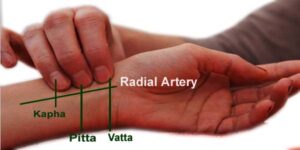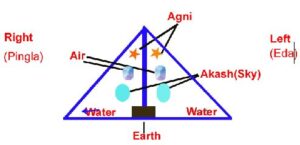Introduction:-
Nadi Pariksha is an Ayurvedic technique of diagnosis through pulse. It can diagnose the physical, mental and emotional imbalance of the patient as well as diseases. It is a non-invasive science in which the root cause of the patient’s diseases is known.
The heart rate (pulse). It is used in Ayurveda , Siddha etc. medical methods.
In this, the index, middle and ring fingers are placed on the radial artery near the wrist of the patient and by applying different pressure, the physician detects the three doshas – Kapha, Vata and Pitta.
The principles of Ayurveda follow the natural way of curing diseases and bringing back balance in the body. In this way nadi pariksha is part of this.
In addition, it is also a scientific tool that enables a person to secure their individual health regimes, which include massage therapy, personalized diet, exercise program, rigorous detoxification and lifestyle-changing experiences.
Nadi Pariksha senses the vibrational frequency of pulsation at different levels on the radial artery. The subtle vibrations are read downwards at seven different levels which help in ensuring various functions in the body. On examining the pulse, both the physical and mental characteristics of the patient are revealed. This is interpreted as symptoms along with their prognosis, which helps to understand the reason. Thus, Nadi Pariksha forms the basis for addressing any ailment in a person.
Key Point for Accurate Nadi Diagnosis

Best Time for Nadi Pariksha
However, the pulse rate varies from time to time and from day to day. Nevertheless
-
-
- Kapha Dosha nadi test should be done in the morning.
- Pitta Dosha should be done in day time.
- Vata Dosha prevails in the afternoon and evening time.
- Free from all kinds of velocity.
-
For accurate diagnosis, it should be done on an empty stomach, early in the morning or three hours after a meal. The reason behind this theory is that once the process of metabolizing food starts, the digestion process gets distorted.
Ayurvedic science explains the phenomenon related to planetary action and influence of Moon and Sun which exerts prime control over the change in the rhythmicity of the nadis.
Patient Examination
To know about the physical condition of the patient and to note the patient’s general demeanor and habits, facial expression, reaction to climatic conditions, appetite, strength, nature of sleep, breathing pattern, ailments. All these facts should be discussed with the patient in order to confirm the diagnosis made through pulse.
Prohibition Time for Nadi Pariksha
- Dont do Nadi Pariksha Immediately after Exercise
- Nadi Pariksha should not be done immediately after eating or when feeling hungry
- Nadi Pariksha should not be done immediately after waking up from sleep and after falling asleep.
Nadi Pariksha Method
Patient Position
With positive thoughts and energy.
The patient’s hand should be free and slightly bent on the forearm, so that the doctor’s left hand gently touches the 3 fingers of the right hand, namely the index, middle and ring fingers. skin over the radial artery. The index finger is placed comfortably near the thumb and the other two fingers are placed next to it (the thumb should be neither too forward nor too motionless).
Examination Procedure

Close your eyes and focus on the finger while examining the nadi
The pulse of the person should be evaluated with three fingers. Vata is established with the tip of the index finger of the right hand on the radial artery next to the root of the thumb of the patient’s right hand, the bile duct is studied by touch. The tip of the middle finger is placed next to it and the cuff is on the pulse artery by touching the tip of the ring finger next to the middle finger.
Five Physical Principle

Relation of Nadi with Breath
| Sense | Disease | |
|---|---|---|
| 1 | Due to the Predominance of Sky Mahabhuta in the body | Tranquilier, Peace, Freedom, Isolation and Loneliness. |
| 2 | Due to the Predominance of Vayu Mahabhuta | Hyperactivity, Confusion, Anxiety ,Fluctuation of emotions. |
| 3 | Due to the Predominance of Agni Element | Competetive , Aggression , Judgemental , Vialent |
| 4 | Due to the Predominance of Water Element | Love , Compession , Attachment , Greed |
| 5 | Due to Predominance of Earth Mahabhuta | Stability Depression Groundedness Heariness |
Normal Pulse Rate of Body
| Pulse | Location | Name of Gati | Characteristics |
|---|---|---|---|
| Vatta Nadi | Index Finger | Sarp Gati(Horizontal) | Fast, Feeble, Superficial, Cold, light, Horizontal, Irregular movement . ** It disappears when you apply more pressure |
| Pitta Nadi | Middle Finger | Manduk Gati | Prominent (vertical spine) Strong, High Amplitude, Hot, throbe, Jumping pulse pushes up, Regularizes. |
| Kapha Nadi | Ring Finger | Hansa Gati | Deep, slow regular but – low amplitude, cold very slow, rough, tired. hard to find. |
